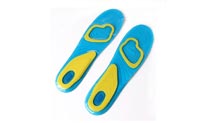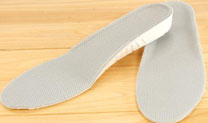As the standard configuration of
running shoes, insoles are neither plugged in and out like chargers of digital products, nor can they be seen and touched everyday like computer mouse, so they are basically ignored by everyone. But for your feet that accompanies you all your life, insoles matter a lot, and greatly affect how you feel when you run. Most of the insoles we usually see are only suitable for walking and not for running. There are two reasons: first, they are not fit for foot shape. And secondly, they are not fit for shoes shape. Running with such insoles is likely to create a scenic spot where the insoles squirm out of the shoes.
1. the characteristics of running insoles should have:
1) The size is appropriate. Do not need to modify when buying it back. Needing to modify the size of them can be considered without any pertinence in a certain extent.
2) Fit foot shape. It means there are different designs according to the different position of the foot, .
3) Good air permeability. Walking on water feels not good, let alone running.
4) Have certain friction. It can avoid foot slipping in shoes and reduce the possibility of sports injury.
5) Have certain cushioning. Although the insole is very thin, it can still play a role in cushioning and improving the comfortable feeling of the foot. This is related to the density and thickness of insole material.
2. How to Choose Running insoles
Sources of insoles:
1) Original insoles: Original insoles are not necessarily the best, but they must fit best for that pair of shoes. The shoes must comfort you so you buy them. Therefore, original insoles are your best choice.
2) Running insoles of other brands: Because different manufacturers have different understandings on their own running shoes, the manufacturing process and materials are different.
3) Third-party general insoles: Many sports brands have independently designed running insoles, and their design capabilities can not be underestimated.
There are three kinds of materials that can be classified as follows:
A. Silica gel material:
This kind of material insoles looks a little like Gel glue of running shoes. The first feet feel is soft and good cushioning. But after wearing for a long time, you will find that this cushioning lacks a solid feeling. The most important thing is that this kind of insoles have almost no air permeability and is not suitable for running.
B. Ortholite material:
Most of the
running insoles are marked with this material. The Encyclopedia of Ortholite explains that it has the advantages of permeability, sweat absorption, odor resistance, mildew resistance, antibacterial effect, good cushioning, better air permeability, lighter weight, water resistance and wear resistance compared with environmentally friendly high polymer sponges. Seemingly high-tech, in fact, it is not very magical, but its characteristics are easy to use and very cheap. I have bought a pair of so-called Ortholite insoles. The actual use of feeling compared with the original insole is not much different. Elasticity, thickness and wear resistance are just suitable. It is a good substitute for the original insole.
C. Multi-material splicing:
Another is to emphasize functional running insoles, the main features of which are applying for multi-material splicing, such as using plastic arch to strengthen support, using embedded cushioning materials in heel or forefoot, etc. The manufacturing process of this type of insoles is relatively complex. The weight is larger and the price is much higher.

